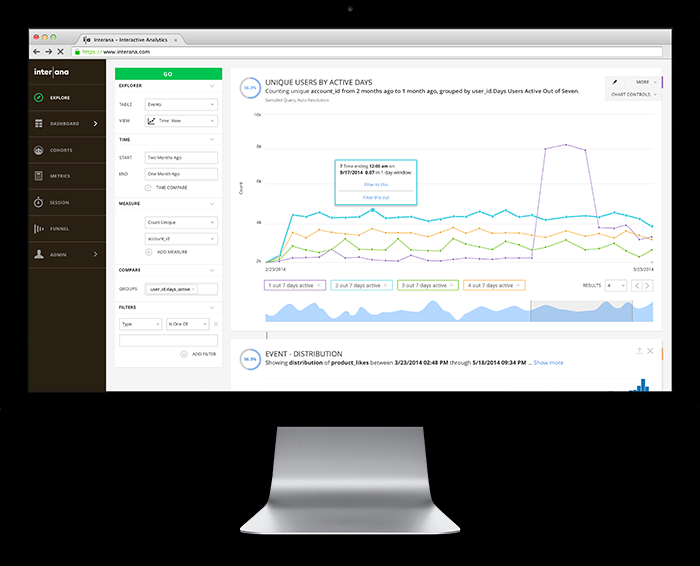
Interana Nabs $20M to Continue Work on Time-Series Analytics

Hadoop may be the top headliner when it comes to big data analytics, but it’s not the only game in town. A case in point is Interana, a Silicon Valley startup that today unveiled $20 million in funding to ramp up development of its tool for exploring massive amounts of time-series data.
Interana‘s software is based on a distributed column-based database that enables fast access to vast amounts of time-series data. Running on X86 servers, the database itself can process 100 million rows per core per second, the company says. On top of this core, Interna developed an interface designed to allow non-technical people to query that raw time-series data–which can be anything from clickstreams and sensor readings to call detail records and change logs–without programming. No SQL knowledge is required.
This represents “a whole new way of looking at data,” says Tony Baer, principal analyst at Ovum. “This is a new form of analytics where streaming data and data at rest are analyzed together, enabling companies to reach the elusive goal of seeing how real-time snapshots fit into historical trends.”
Many of Interana’s early adopters are using the software to better know their customers, which often takes the form of parsing clickstreams from a website or mobile applications. They want to know what’s working on the sites or apps, what’s turning customers off, and they’re using Interana’s tool to explore the data through this lens.
There are other ways to do this sort of work. But what sets Interana apart is the immediacy of the results and the freedom to explore raw data in practically any way the user wants, says Interana co-founder and CTO Bobby Johnson, who previously was director of engineering at Facebook.
“It’s just the immediate interactivity, that even on this huge data set, I can jump in and look at it,” he tells Datanami. “When you talk about it in the abstract, they say, ‘Yeah I know what my numbers are.’ But when you’re actually able to drill in right there on the tool into anything, people just light up. They love it. One of our customers said they didn’t even realize this was a thing they needed until they tried it.”
Website operators aren’t the only firms giving Interana a shot. The company is also selling software or doing proof of concepts (POCs) with banks that are trying to detect time-based patterns in customer behavior, such as whether visits to bank branches versus ATMs can be used to determine if somebody is on vacation.
Companies that sell “wearables” could also be potential Interana customers. For example, certain patterns of steps could indicate a healthy person or somebody who’s not healthy. “There’s lots of things to understanding your users in different types of products,” says Ann Johnson, Interana’s CEO and co-founder and Bobby Johnson’s wife.
Most of Interana’s early customers–Asana, Orange Silicon Valley and BloomBoard are the ones listed on its website–are technology companies that have programming expertise. However, they would prefer not to cobble together their own solutions using open source tools, according to Ann Johnson.
“Most of our customer and potential customers are tech companies. They are people who have developers on hand,” she says. “They just don’t want to pay to build a whole new department just to run their analytics.”
Customers could conceivable analyze this time-series data in other tools, such as within Hive or Impala running on Hadoop or the data exploration software from Tableau. The downside of using a SQL solution on Hadoop is the amount of programming required and worse performance, while using a tool like Tableau would require “rolling up” the data to make it fit, Bobby Johnson says.
“If I have 10 million actions my users took, I can’t load that it Tableau. I basically have to roll it up first, and that’s a programming task,” he says. “Somebody has to do the work to decide beforehand what’s going to land in Tableau, which dimensions you can slice, rather than just having access to the raw data to look at anything you want.”

Interana focused on making its interface for exploring time-series data very intuitive for non-technical users
The ability to explore massive data sets without preset conditions, or what’s called schema on read, is also one of the core precepts of Hadoop and what has made the Hadoop Distributed File System (HDFS) such a popular place to store poly-structured data that doesn’t fit neatly into a relational database.
Interana is not fighting against the Hadoop current. In fact, running the Interna tool within Hadoop is still on the roadmap. But for now, the company is happy running outside of Hadoop, where life is arguably simpler.
Interestingly, Interana’s Hadoop connection got stronger with today’s announcement. One of the company’s new investors is Mike Olson, Cloudera‘s chief strategy officers and one of its co-founders. The $20 million Series B round also includes an investment from Mike Volpi, a partner at Index Ventures, which led the round and is among the earlier backers of Hadoop distributor Hortonworks.
“Interana provides Big Data insights to large numbers of people within an organization by making insights quicker and easier to access than ever before,” says Volpi, who also gains a seat on the board.
The company will use the $20 million to scale up its engineering and sales departments. The company currently has 37 employees.
Related Items:
Stealth Startup Looks to Crack the Time Barrier
Pulling Insights from Unstructured Data – Nine Key Steps
The Secret to Generating Value from IoT Data


























